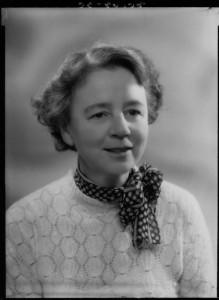Still She Wished for Company is a timeslip story – a true one, the author suggests – about a psychic connection between two women living a hundred years apart. There is independent Jan, perhaps in her mid-20s and living in 1920s London; and innocent Juliana, in her late teens and living with her family in their great house in the 18th century. These two are aware of each other and occasionally appear in each other’s time, without understanding how or why, and the link between them is encouraged by Juliana’s dissolute elder brother, Lucian. He too has a psychic ability, and he and Jan are attracted to each other.
The theory seems to be that the barriers of time can be crossed, if there is sufficient will. Perhaps Still She Wished was suggested in part by the increased interest in spiritualism after the First World War, by a desire for communication with the dead.
This is Margaret Irwin’s first novel and, until I was looking for a not-too-scary supernatural story, I didn’t know that she wrote anything like this. Her best-known work is her historical trilogy about Elizabeth I: Young Bess, Elizabeth, Captive Princess and Elizabeth and the Prince of Spain. She usually focused on real people and events and was admired for her re-creations. But Margaret Irwin also wrote a number of respected ghost stories and These Mortals about a wizard and his daughter.

Margart Irwin by Bassano, half-plate glass negative, 27 July 1939. Creative Commons licence, NPG
If you set aside the supernatural elements, you can see in Still She Wished how Margaret Irwin wrote her acclaimed books. It has many of the elements of a fine historical novel. The 18th century section conveys the atmosphere of a great country house and the concerns and pleasures of its inhabitants. We see Juliana dutifully visiting old retainers, writing in her journal, in company and at a ‘water party’ (travelling down river by barge to a ‘fête champêtre’). This is particularly well done: silks and satins, country dances and minuets and the ‘carved and gilded barge, monstrous and magnificent, under its scarlet awning, on the glittering, sunlit river’.
We also learn about the strict hierarchy of 18th century society. Juliana’s brother Lucian has a bad reputation but he is without question the head of the family, with the title and money, and everyone else – his mother and grandmother, his younger brothers, the servants – is in his power. It never occurs to Juliana to refuse to join his psychic experiments (indeed she is flattered by his notice and attracted by his glamour), even though she is frightened.
Again she felt that strange shrinking as he laid his hand on her shoulder to steady her while she took the chocolate, and she thought he must have felt her shiver.
The 20th century section, which is very short, suggests that Margaret Irwin could also have written the sort of domestic fiction often explored in this blog. Jan lives in cramped conditions at home with her mother and sister. There does not seem to be much money, and there’s a suggestion that they have come down in the world.
Three-quarters of an hour later, she plunged, bedraggled and dripping, into a small room where a worn-faced woman sat at a sewing machine among a quantity of heterogeneous articles. A tall, largely-built girl who sat on the floor, half covered with stockings, got up clumsily, scattering them in all directions, and flung herself on the intruder with the eagerness of a prisoner who has seen a chance of escape.
Jan works in an office, at a dull job. There is a decent but rather dour, young man, Donald, who loves her, but is not making much progress as Jan thinks about the portrait she has seen of a mysterious 18th century gentleman.
But when he was unable to hold her attention, or, most of all, when he sometimes caught in her a look of delighted expectancy, a look that was surprisingly radiant, sparkling and intimate to herself; then he felt jealous of her thoughts, whatever they might be, that could draw her so securely from him.
The two sections of the novel work well by themselves, but less well together. The balance between them is not right, with Jan’s story being crammed into a few pages at the beginning and end. I was left feeling cheated and wondering if interleaving the stories might have worked better.
One last thing. ‘Still she wished for company’ sounds like a quotation, but I can’t find it. Does anyone know it?

